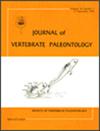最早出现在南亚的马属动物
IF 1.9
4区 地球科学
Q2 PALEONTOLOGY
引用次数: 1
摘要
本文章由计算机程序翻译,如有差异,请以英文原文为准。
The earliest occurrence of Equus in South Asia
ABSTRACT Fossil horses are ubiquitous members of late Neogene and Quaternary ecosystems in Eurasia and Africa. The genus Equus is conventionally thought to be a Pleistocene immigrant into Eurasia from North America, and the concurrent appearance of these monodactyl equids in Eurasia around 2.58 Ma is accepted as the Equus Datum. Here, we report on a specimen of Equus found near the village of Jhil, from the latest Pliocene of the Upper Siwaliks of India. The specimen was recovered from sediments that are lithologically equivalent to the Upper Pliocene Saketi Formation, and have been dated paleomagnetically to lie just below the Gauss–Matuyama boundary, therefore, the latest Pliocene. Our comparative work shows that the anatomy of Jhil specimen is consistent with the Early Pleistocene Siwalik horse, Equus sivalensis. Our finding extends the temporal distribution of this species into the latest Pliocene, and adds to our understanding of the variation in this species of horse. We also argue that along with potential latest Pliocene occurrences of Equus from Europe, and accounting for the Signor–Lipps effect, the Equus Datum should be revised as a latest Pliocene event.
求助全文
通过发布文献求助,成功后即可免费获取论文全文。
去求助
来源期刊
CiteScore
2.90
自引率
7.10%
发文量
58
审稿时长
4-8 weeks
期刊介绍:
The Journal of Vertebrate Paleontology publishes original contributions on all aspects of vertebrate paleobiology, including vertebrate origins, evolution, functional morphology, taxonomy, biostratigraphy, phylogenetics, paleoecology, paleobiogeography, and paleoanthropology. JVP publishes high quality peer-reviewed original articles, occasional reviews, and interdisciplinary papers. It is international in scope, and emphasizes both specimen- and field-based based research and the use of high-quality illustrations. Priority is given to articles dealing with topics of broad interest to the entire vertebrate paleontology community and to high-impact specialist studies. Articles dealing with narrower topics, including notes on taxonomic name changes (unless these deal with errors published in JVP), preliminary site reports, and documentation of new specimens of well-known taxa, are afforded lower priority.

 求助内容:
求助内容: 应助结果提醒方式:
应助结果提醒方式:


